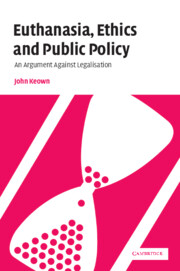Book contents
- Frontmatter
- Contents
- Preface
- Foreword
- Acknowledgments
- Table of cases
- List of abbreviations
- Introduction
- PART I Definitions
- PART II The ethical debate: human life, autonomy, legal hypocrisy, and the slippery slope
- PART III The Dutch experience: controlling VAE? condoning NVAE?
- PART IV Australia and the United States
- PART V Expert opinion
- PART VI Passive euthanasia: withholding/withdrawing treatment and tube-feeding with intent to kill
- Conclusions
- Afterword
- Bibliography
- Index
- Frontmatter
- Contents
- Preface
- Foreword
- Acknowledgments
- Table of cases
- List of abbreviations
- Introduction
- PART I Definitions
- PART II The ethical debate: human life, autonomy, legal hypocrisy, and the slippery slope
- PART III The Dutch experience: controlling VAE? condoning NVAE?
- PART IV Australia and the United States
- PART V Expert opinion
- PART VI Passive euthanasia: withholding/withdrawing treatment and tube-feeding with intent to kill
- Conclusions
- Afterword
- Bibliography
- Index
Summary
There are few more momentous and controversial questions facing contemporary society than the legalisation of voluntary, active euthanasia (VAE) and active physician-assisted suicide (PAS). The campaign for their legalisation shows little sign of abating. In January 1997, campaigners for PAS argued their case before the United States Supreme Court. They had persuaded two Federal Appeal Courts that the US Constitution recognised a right of mentally competent, terminally ill patients to PAS. Unanimously, the Supreme Court reversed both decisions.
As the Supreme Court's decisions illustrate, despite the popular support the campaign for legalisation seems to enjoy and the considerable media attention it has generated, the campaign has as yet enjoyed surprisingly little success in changing laws around the world. This is largely because opposition to change remains strong. That opposition is partly based on the view that it is always morally wrong for one person, doctor or not, intentionally to kill another innocent person, even at their request. But it is also rooted in the concern that if VAE/PAS were permitted they would not remain voluntary for long, and that patients who did not really want to die, or who were not suffering severely, or whose suffering could be alleviated by palliative medicine, would nevertheless have their lives terminated. Indeed, fear of this ‘slippery slope’ is proving to be the major obstacle to reform. But is this fear justified or illusory?
- Type
- Chapter
- Information
- Euthanasia, Ethics and Public PolicyAn Argument Against Legalisation, pp. xi - xiiPublisher: Cambridge University PressPrint publication year: 2002

